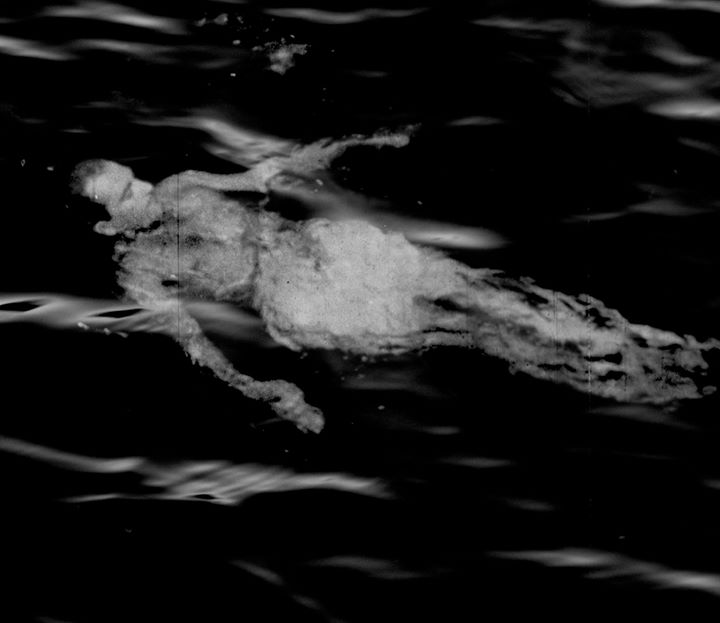anticipated artists in person: Brianna Nelson, Greta Snider, Natalie Tsui
presented by San Francisco Cinematheque and San Francisco Museum of Modern Art
in association with the Canyon Cinema Foundation
Admission: $12 general/$10 Cinematheque and SFMOMA members with member code
Advance tickets available on May 1 here.
Join our Facebook event.
From far beneath the ocean waves to the outer rings of Saturn, the films in this program present distant mental landscapes and consider isolation and human connection; resiliency; fantastical visions of withdrawal; escape and reconvergence; conditions of captivity and resistance. Waves roll, parallel to the zodiac, as senses reel and planets turn.
This program is dedicated to the memory and transcendent vision of filmmaker Peter Hutton (1944–2016).
SCREENING
Moon Tendon (2015) by Jamilah Sabur; digital video, black and white, sound, 12 minutes, exhibition file from maker bay area premiere
A love letter to the moons of Saturn. Moon Tendon is a perceptual play with texture, space and locomotion. Sabur's stream of consciousness work, presents Galileo as a life-sized doll-like figure with bells in his mouth; and incorporates open source NASA footage of a hurricane on Saturn swirling inside a large, mysterious, six-sided weather pattern known as “the hexagon.” An encounter with Galileo’s Acceleration Experiment and his writings to the Duke of Tuscany about his observations of Saturn’s rings in 1610 influenced the arrangement of the video. Alternating between found footage, a constructed set and recruiting Robert Smithson’s Spiral Jetty to perform on. Moon Tendon features Tendon, a score created by American composer Jon Forshee on UPIC, a computerized musical composition tool, devised by Iannis Xenakis. (Jamilah Sabur)
The Rules of the Game (2015) by Julia Dogra-Brazell; digital video, color, sound, 4 minutes, exhibition file from maker bay area premiere
A meditation on time, perception and the moving image fashioned from two seemingly disconnected narrative sources. Half enunciated words and phrases from Charlotte Perkins Gilman’s “The Yellow Wallpaper”—a cautionary tale on the perils and extravagances of seeing and being seen—qualify extracts from the filmmaker’s own correspondence on film and photography that forms the auditory foreground to this film. Gilman’s short story was published at the start of photography’s ascendancy and just three years before the arrival of the first moving image made for projection. (Julia Dogra-Brazell)
Skin in the Game (2017) by Ariana Gerstein; digital video, black and white, sound, 5 minutes, exhibition file from maker world premiere
A way of working, from many pieces, marked by light, by pressure, sliced. An editing process that is extremely non-linear, sculpted. Beginning with outtakes from previous films and found footage which has been cut, painted, turned into a glass-mounted collage, re-scanned, animated, edited from analog to digital. (Ariana Gerstein)
Space (2015) by Emmanuel Piton & Emilie Morin; digital video, color, sound, 5 minutes, exhibition file from makers U.S. premiere
A crossing in space, material deforms and transforms. The film is destroyed, burnt, pierced to reveal new configurations, a new sensitive space. (Emmanuel Piton & Emilie Morin)
In Titan's Goblet (2015) by Peter Hutton; 16mm, color, sound, 10 minutes, print from Canyon Cinema
…refers to a landscape painting by Thomas Cole circa 1833. The film is intended as a homage to Cole, who is regarded as the father of the Hudson River School of painting. (Peter Hutton)
Rendition (2015) by Greta Snider; digital video, black and white, sound, 9 minutes, exhibition file from maker
Human beings have incredibly complex sensory capabilities—it’s really the lovely thing about people, and the redeeming quality, you might say. We feel and think, and interpret signals from within and without. Unfortunately, that is why sensory deprivation (or solitary confinement) is characterized as torture. We can’t turn these sensory systems off. If our bodies are deprived of input, then these sensory systems turn exclusively inward, searching and amplifying the signals of the body. The process virtually cannibalizes the body’s signals, to sustain the body’s own need for connection. So in truth, “sensory deprivation” in a misnomer—the torture technique would more accurately be called “external sensory deprivation.”
Rendition is an exploration lamenting this idea. Our inner landscapes are beautiful and compelling to visit, but most of us are relieved to wake up from dreams, and to be oriented by a horizon.
While researching another project, I found a phrase that was repeatedly used in the memos generated by the Office of Legal Counsel regarding torture policy. “Individual detainees may respond differently” to the described torture techniques, such as waterboarding or mock execution. It occurred to me that the experience of sensory deprivation produces a particularly individuated response—the thoughts, images and sounds emerge from within the boundaries of one’s own body. What might that be for each of us?
I am constantly bewildered by how much creativity human beings can put into the endeavor of making other human beings miserable. I think it’s important to remember this, whether we are personally implicated in this kind of exchange or not. (Great Snider)
Pulling a Gray Rearview Rapture (2016) by Brianna Nelson & Natalie Tsui; digital video, color, sound, 3 minutes, exhibition file from makers
Within the context of a visual archive, the original memory associated with an image detaches from the experience represented, leaving the image open to nostalgic interpretation. In this sense the archive exists, not as a document of the past, but rather, as a tool of recorded collective memory for the future viewer to scrutinize or appropriate as necessary.
Recontextualizing records of collective memory within the future viewer’s individual lens imbues them with new meaning. By mapping our individual, contemporary concerns onto the archive, the past becomes simultaneously at our disposal and unrecognizable, requiring us to confront the contradictory coexistence of memory loss and narrative construction.
For Pulling a Gray Rearview Rapture, we searched the Prelinger Archives for documentation of queer experience but found instead rich subtext of repressed desire. We culled moments of intimacy between watched women into glimpses of what might exist beyond scrutinized performances for the camera, acknowledging that our own desires impose interpretation that limits connection to the original memories associated with the images. The final video is both a result of and a reflection on interpreting visual archives through individual experience as we situate ourselves in relation to history and each other. (Natalie Tsui & Brianna Nelson)
This Bogeyman (2016) by Pere Ginard; digital video, color, sound, 3 minutes, exhibition file from maker world premiere
The bogeyman is a common allusion to a mythical creature in many cultures used by adults to frighten children into good behavior. This monster has no specific appearance, and conceptions about it can vary drastically from household to household within the same community; in many cases, he has no set appearance in the mind of an adult or child, but is simply a non-specific embodiment of terror. (Pere Ginard)
Les eaux dormantes (Sleeping Waters) (2016) by Emmanuel Piton; digital video, color, sound, 17 minutes, exhibition file from Vidéographe U.S. premiere
Under the lake, the earth draws the ways you can take. In the depth of the sleeping waters, a roar sounds, probably a coming revolt. (Emmanuel Piton)
Pictured above: Rendition (2016) by Greta Snider
CROSSROADS 2017 is generously supported by: National Endowment for the Arts, Fleishhacker Foundation, Grants for the Arts, Zellerbach Family Foundation, George Lucas Family Foundation, Owsley Brown III Philanthropic Foundation and the Willow Foundation.
With thanks to our festival sponsors:

